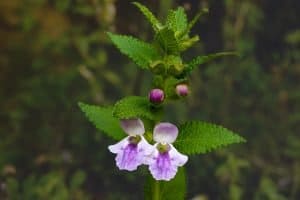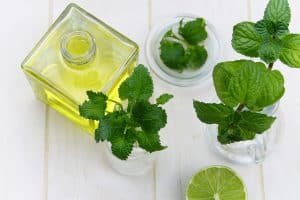What is Lemon Balm Plant?
Lemon balm (Melissa officinalis) is an ancient herb that is related to mint. It is a member of the mint family and is a perennial herb. It grows like a fertile and leafy herb with a pleasant lemon scent and small white flowers.
This plant usually grows to a height of 1 to 3 feet and 1.5 to 3 feet wide. The leaves are bluish-green color and give a sweet lemon scent, similar to mint. The flowers are white in color and appear in the flowering season, which is summer. These flowers are full of nectar so bees are attracted to this plant.

The lemon balm uses as a medicine can be traced back to ancient Greece and Rome, and was a common herbal remedy in the Middle Ages in Europe. Plant historians believe that it reaches the New World shortly after the first settlers and is now established all over the world. The leaves of the plant are useful on various tonics and teas, and its essential oil is extracted and used in multiple ways.
Scientific Classification of Lemon Balm Plant
Kingdom: Plantae
Order: Lamiales
Family: Lamiaceae
Genus: Melissa
Species: M. Officinalis
Varieties of Lemon Balm Plant
There are different varieties of Lemon Balm plants. Some popular ones are listed below and explained in detail.
Variegated Lemon Balm
The variegated lemon balm is a perennial herb that is part of the mint family. It usually grows to a height of 5-7 inches, and this cultivar is best grown in pots. This plant has a strong mint flavor and is widely used in cooking dishes and aromatherapy. The foliage is colorful green and yellow in color.
Quedlinburger Lemon Balm
This plant is a perennial plant that is easy to cultivate. It typically grows to a height of 30 cm and has a width of 40 cm. Its associated plants are tomatoes, mint, chives, basil, and parsley. This plant is best grown outdoors from February to July. Seed germination takes about 1-2 weeks. Harvesting can take 40 to 60 days.
Aurea Lemon Balm
This cultivar has wavy oval leaves. Sometimes, small yellow flowers appear in the flowering season, on irregular tips. The leaves are uses to make lemon juice. One thing that distinguishes this variety is that it can grow in poor soils. As they grow, plants should space 1 to 2 feet apart so that the roots have enough room to grow.
Lemonella Lemon Balm
This variety has bright green leaves that have a strong lime smell. It is drought-resistant and relatively easy to grow. It is a perennial plant that should be spaced between 18 and 24 inches at the time of cultivation to ensure good air circulation. The seed of this plant nearly takes two weeks to germinate.

How to Grow Lemon Balm Plant?
Lemon balm can quickly grow in your garden or containers. They grow in almost all soils, but they prefer fertile and well-drained soils. Lemon balm plants grow in partial shade but will thrive in full sun.
From Seed
- Spread seedlings in early spring by spraying the seeds on the soil surface or merely covering them lightly with the soil, as this plant needs light to germinate.
- Add compost if you wish, although this herb does not require special soil conditions.
- The seed will sprout in 5-9 days should increase the soil temperature between 65-70 degrees Fahrenheit.
- You can also choose indoor apartments or in a greenhouse in early spring to start seedling.
- Sprinkle the seeds in the trays on top of the potting soil and keep them moist until they grow.
From Cutting
Lemon balm can easily grow from cuttings in spring or autumn. To propagate from cuttings, you only need to cut a few inches from the soft tips of a grown plant. In the spring, cuttings should be taken a few inches below the tip of the new growth. In the fall, they should emerge from the stems closest to the base of the crown that has not bloomed.
- Remove two-three leaves from the bottom of each stem and pinch the tips to prevent them from wilting.
- Next, drain the stems and place them in a sterile mixture of planting with coarse sand equal parts to retain moisture. You can also keep them in a container with water if you want to witness the roots growing.
- Keep them away from direct sunlight, and plants will take about 3-4 weeks to germinate root.
- When you can see a dozen of roots, plant them either in a pot or to your garden.
Here is a video on how to grow lemon balm plants indoor.
How to Care Lemon Balm Plant?
Lemon balm spreads to the roots underground. To prevent lemon balm from being invasive, place it in the garden in a bottomless container that will keep the roots in place. Lemon balm plants are easy to grow in your garden and to grow it healthy, we must take care of it.
Location
Lemon balm needs full sun and bear shade too. Grow lemon balm in a well-drained sandy loam. However, lemon balm will grow almost in all soils but not in humid soils.
Watering
Lemon balm requires regular watering. It grows in slightly damp soils and can also tolerate dry soil when it becomes mature enough.
Diseases that may harm lemon balm
Lemon balm is susceptible to the withering of verticillium, mint rust, and powder mold. To prevent these fungal diseases, maintain adequate plant spacing to allow for good air circulation. Spray the plants with compost tea throughout the season; Compost tea is a natural fungicide.

Uses of Lemon Balm Plant
Lemon Balm has many uses from cooking, home-made cosmetic, and medicinal purposes.
- It is useful in oils and hair rinses, steam, salves, creams, lip balms, and baths.
- The flowers are edible, so they can candid or used to garnish fruit salads, beverages, and desserts.
- Lemon balm as herbs creates a sweet and citrusy drinking vinegar that can add to cocktails, sodas, or other beverages.
- The fresh or dried leaves make the tea light and refreshing. The infusion of fresh or dried leaves has a refreshing citrus flavor that relieves stomach pain.
- Lemon balm has a compound called Rosmarinic Acid, which has antioxidant and antimicrobial properties that relieve stress and anxiety.
- Lemon balm tea can help to treat symptoms of dyspepsia (upset stomach).
- It also cures irritable bowel syndrome (IBS), and acid reflux.
- Lemon balm helps to relieve menstrual cramps and premenstrual syndrome.
